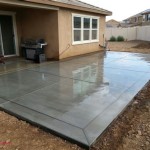How to Paint Your Patio Concrete Floor
Painting a concrete patio floor is a relatively straightforward and cost-effective way to enhance its appearance, protect it from the elements, and potentially increase its longevity. A fresh coat of paint can transform a dull, gray slab into a welcoming and aesthetically pleasing outdoor living space. However, proper preparation and application are crucial to ensure a durable and long-lasting finish. This article provides a detailed guide on how to paint a concrete patio floor.
Preparing the Concrete Surface: The Foundation for Success
Surface preparation is arguably the most critical step in painting a concrete patio floor. A properly prepared surface allows the paint to adhere correctly, preventing premature peeling, chipping, and blistering. Skipping or skimping on this step will almost certainly lead to a subpar and short-lived result.
First, the surface must be thoroughly cleaned. Begin by sweeping away all loose debris, such as leaves, dirt, and grass clippings. A stiff-bristled broom is ideal for this task. Next, wash the concrete with water and a concrete cleaner or degreaser. These specialized cleaners are designed to remove oil, grease, and other stubborn stains that can hinder paint adhesion. Follow the manufacturer's instructions for dilution and application. For heavily soiled areas, consider using a pressure washer. Be careful not to use excessive pressure, as this can damage the concrete surface.
After washing, inspect the concrete for cracks and repairs. Small cracks can be filled with a concrete crack filler. Larger cracks and damaged areas may require more extensive repairs using a concrete patching compound. Allow the patching compound to dry completely according to the manufacturer's instructions. Once dry, sand the patched areas smooth to blend them seamlessly with the surrounding concrete.
Efflorescence, a white, powdery substance that appears on concrete surfaces, must also be removed. Efflorescence is caused by salt deposits rising to the surface. It can be removed by scrubbing the concrete with a wire brush and a solution of water and muriatic acid. Exercise extreme caution when handling muriatic acid. Wear appropriate safety gear, including eye protection, gloves, and a respirator. Always add the acid to the water, never the other way around, to prevent a dangerous chemical reaction. Thoroughly rinse the concrete with water after applying the muriatic acid.
Finally, etching the concrete surface is often recommended to further improve paint adhesion. Etching creates a slightly rough texture, providing the paint with more "tooth" to grip. This can be achieved using a concrete etching solution or muriatic acid. Again, follow the manufacturer's instructions and safety precautions carefully. After etching, rinse the concrete thoroughly and allow it to dry completely before proceeding.
Selecting the Right Paint and Primer: Ensuring Durability and Aesthetics
Choosing the right paint and primer is essential for achieving a durable and aesthetically pleasing finish. Concrete is a porous material that can absorb moisture, so it's important to select a paint specifically designed for concrete floors. These paints are typically formulated to resist moisture, abrasion, and chemicals.
Several types of paint are suitable for concrete patio floors, including acrylic latex paint, epoxy paint, and concrete stain. Acrylic latex paint is a popular choice due to its ease of application, durability, and relatively low cost. It is water-based, making it easy to clean up and less harmful to the environment than solvent-based paints. Epoxy paint offers superior durability and resistance to chemicals and stains. It is a two-part system that requires mixing a resin and a hardener. Epoxy paint is a good choice for high-traffic areas or patios that are exposed to harsh weather conditions. Concrete stains penetrate the concrete surface, creating a permanent color that won't peel or chip. Stains offer a more natural look than paint and are available in a variety of colors.
Before applying the paint, it is crucial to apply a concrete primer. Primer improves paint adhesion, seals the concrete surface, and helps prevent moisture from seeping through. Choose a primer specifically designed for concrete floors and compatible with the type of paint being used. Apply the primer according to the manufacturer's instructions, typically using a roller or brush. Allow the primer to dry completely before painting.
When selecting a paint color, consider the overall aesthetic of the outdoor space and the surrounding environment. Lighter colors can make a small patio appear larger, while darker colors can create a more intimate and cozy atmosphere. Also, consider the potential for fading in direct sunlight. Some colors are more prone to fading than others. Check the paint manufacturer's specifications for lightfastness and UV resistance.
Before starting the entire project, it is highly recommended to test the paint and primer in an inconspicuous area of the patio. This will allow one to assess the color, adhesion, and overall appearance before committing to the entire project. Apply the primer and paint to a small area and allow it to dry completely. Then, inspect the area for any issues, such as peeling, blistering, or color inconsistencies.
Applying the Paint: Achieving a Professional Finish
Once the concrete surface is properly prepared and the appropriate paint and primer have been selected, the application process can begin. Applying the paint correctly is essential for achieving a professional-looking and durable finish.
First, gather all the necessary tools and materials. These typically include paint rollers, paint brushes, paint trays, painter's tape, and a stirring stick. Use painter's tape to mask off any areas that need to be protected from paint, such as walls, steps, or landscaping features. Stir the paint thoroughly to ensure that the pigments are evenly distributed. Pour some paint into the paint tray.
Begin by painting the edges of the patio floor with a brush. This will create a neat and clean edge. Then, use a roller to apply the paint to the main surface of the patio. Work in small sections, overlapping each stroke to ensure even coverage. Apply the paint in thin, even coats, avoiding drips and runs. Allow the first coat of paint to dry completely according to the manufacturer's instructions.
Once the first coat is dry, apply a second coat of paint. This will provide better coverage and durability. Again, apply the paint in thin, even coats, overlapping each stroke. Allow the second coat to dry completely before walking on the patio. The drying time will vary depending on the type of paint and the weather conditions. Refer to the paint manufacturer's instructions for specific drying times.
For high-traffic areas or patios that are exposed to harsh weather conditions, consider applying a clear concrete sealer after the paint has dried completely. A sealer will provide added protection against moisture, abrasion, and chemicals. Apply the sealer according to the manufacturer's instructions, typically using a roller or brush.
After applying the final coat of paint or sealer, carefully remove the painter's tape. Be sure to pull the tape away from the painted surface to avoid peeling off the paint. Allow the patio floor to cure completely before placing furniture or other items on it. Curing times can vary depending on the type of paint and sealer used. Refer to the manufacturer's instructions for specific curing times.
During the painting process, it is important to work in a well-ventilated area. If painting indoors or in an enclosed space, open windows and doors to provide adequate ventilation. Wear appropriate safety gear, such as gloves and a mask, to protect against paint fumes. Clean up any spills or drips immediately with a damp cloth. Dispose of used paint cans and brushes properly according to local regulations.
By following these detailed steps, one can successfully paint a concrete patio floor and transform it into a beautiful and functional outdoor living space. Proper preparation, careful selection of materials, and meticulous application are key to achieving a durable and long-lasting finish.

Diy How To Paint Concrete Patio Painting Stain

How To Paint A Concrete Porch Or Patio
:max_bytes(150000):strip_icc()/faux-painted-rug2-5d0d2b1a8ddd4c60a39ffd329840874e.jpg?strip=all)
19 Painted Concrete Patio Designs
:max_bytes(150000):strip_icc()/painted-concrete-patio-1-2cb8e70c07074006b34800edbf090eba.jpg?strip=all)
19 Painted Concrete Patio Designs

How To Paint A Concrete Porch Or Patio

How To Repaint A Painted Concrete Porch Cuckoo4design
:max_bytes(150000):strip_icc()/daich-spreadstone-lake-rock-6-3ab3bb3a18174350a09f0389e2144a32.jpg?strip=all)
19 Painted Concrete Patio Designs

How To Paint A Concrete Porch Or Patio

Backyard Makeover How To Paint Concrete Look Like Oversize Pavers A House Full Of Sunshine

How To Paint A Concrete Patio With Tutorial Tips
Related Posts








